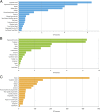Does aquaculture add resilience to the global food system?
- PMID: 25136111
- PMCID: PMC4169979
- DOI: 10.1073/pnas.1404067111
Does aquaculture add resilience to the global food system?
Abstract
Aquaculture is the fastest growing food sector and continues to expand alongside terrestrial crop and livestock production. Using portfolio theory as a conceptual framework, we explore how current interconnections between the aquaculture, crop, livestock, and fisheries sectors act as an impediment to, or an opportunity for, enhanced resilience in the global food system given increased resource scarcity and climate change. Aquaculture can potentially enhance resilience through improved resource use efficiencies and increased diversification of farmed species, locales of production, and feeding strategies. However, aquaculture's reliance on terrestrial crops and wild fish for feeds, its dependence on freshwater and land for culture sites, and its broad array of environmental impacts diminishes its ability to add resilience. Feeds for livestock and farmed fish that are fed rely largely on the same crops, although the fraction destined for aquaculture is presently small (∼4%). As demand for high-value fed aquaculture products grows, competition for these crops will also rise, as will the demand for wild fish as feed inputs. Many of these crops and forage fish are also consumed directly by humans and provide essential nutrition for low-income households. Their rising use in aquafeeds has the potential to increase price levels and volatility, worsening food insecurity among the most vulnerable populations. Although the diversification of global food production systems that includes aquaculture offers promise for enhanced resilience, such promise will not be realized if government policies fail to provide adequate incentives for resource efficiency, equity, and environmental protection.
Keywords: crop resources; diversity; food portfolio management; global change; shocks.
Conflict of interest statement
The authors declare no conflict of interest.
Figures




References
-
- Food and Agriculture Organization of the United Nations 2013. FAOSTAT (Food and Agriculture Organization, Rome)
-
- Food and Agriculture Organization of the United Nations 2013. FISHSTAT Plus: Universal Software for Fishery Statistical Time Series (Food and Agriculture Organization, Rome), Version 2.32.
-
- Tacon AGJ, Metian M. Fish matters: Importance of aquatic foods in human nutrition and global food supply. Rev Fish Sci. 2013;21(1):22–38.
-
- Hall SJ, et al. Blue Frontiers: Managing the Environmental Costs of Aquaculture. Malaysia: WorldFish Center, Penang; 2011.
-
- Smith ADM, et al. Impacts of fishing low-trophic level species on marine ecosystems. Science. 2011;333(6046):1147–1150. - PubMed
MeSH terms
LinkOut - more resources
Full Text Sources
Other Literature Sources
Research Materials

